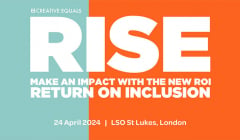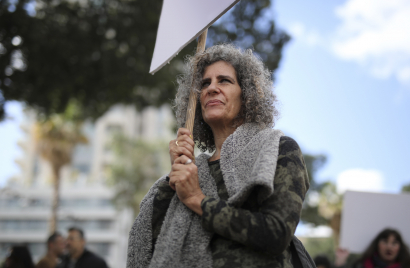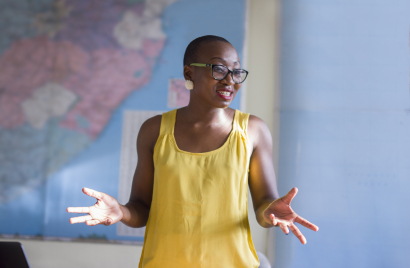
The 2024 Creative Equals RISE Trend Report is live
Hear from marketing leaders at brands including Diageo, Reckitt and Dr Martens about how diversity drives creativity.

Dr. Rebecca Swift, Global Head of Creative Insights at Getty Images reflects on the distance the industry has come, and the work it still has to do when it comes to the representation of women.

I pledge to use imagery that feels genuine and represents the women I know.
I pledge to challenge beauty stereotypes.
I pledge to show a wider range of beauty in marketing and campaigns.
I pledge to hire more female photographers.
These are the pledges many of the world’s top brands and agencies made in 2019 at Cannes Lions as Getty Images, in partnership with Dove and Girlgaze launched Project #ShowUs to the advertising industry. The moment felt significant, it felt like we were marking a step change in how women around the world are represented in all our diversity, across age, ability, gender expression, sexual orientation, ethnic and cultural backgrounds and religious beliefs. So, as the collection turns two, how far have we come?
I am gratified to see how agencies and brands have embraced the collection, with images downloaded over 42,000 times by over 4,900 companies globally. It has also been exciting to see and support over 200 female-identifying and non-binary photographers in 41 countries who have contributed to the collection, including 85 new content creators, now including videographers, since launch.
We also saw the collection impact what customers are searching for around the representation of women on gettyimages.com. Following the launch of the collection, global customer searches on gettyimages.com increased for ‘real woman’ up 150%, ‘natural beauty’ up over 100% and ‘body positive’ up over 470% while new search terms appeared such as ‘unretouched’ and ‘authentic woman’.
More recently, the most downloaded images of ‘woman’ in 2020 by customers on gettyimages.com show us the advertising industry is embracing more ethnically diverse portrayals of women, with the top selling images inclusive of Asian, Black and Caucasian women.
The most overwhelming sense you get when you look at the most popular content though is that it represents a realistic range of body shapes.
Dr Rebecca Swift
And there is still much work to be done. In a survey carried out for Getty Images’ insights platform Visual GPS in 2020, 9% of women in the UK said they do not feel they are well represented in advertising, and business communications is only marginally better (7%).
Additionally, of those women who reported feeling discriminated against, 45% of women said it is because of their body, shape or size and 36% reported discrimination because of the way they look, dress or present themselves. It’s clear the advertising industry has an urgent responsibility and opportunity to impact behavioural change for the better.
The COVID-19 pandemic has not helped, of course. The disproportionate impact of lockdown on women, whether it be job loss or the impossible task of home schooling while trying to deliver against a full-time job, has been well documented.
But many brands have risen to the challenge and started to communicate in a more empathetic way, bringing a new level of inclusivity to the visualisation of the universal human experience during this time.
Our Visual GPS research tells us that the ideals Project #ShowUs champions, inclusive and accurate representation, are top of mind for consumers also; 85% of people in the UK want to see companies showing people with all body shapes and types in their communications while a further 62% of respondents say it’s important to them that the companies they buy from celebrate diversity of all kinds.
We have seen how our own customers are addressing this through the content that has been most popular from the collection to date. We have seen content being used that spans all regions, cultures, ethnicities and the women are all ages with disabilities, scars, diverse hair styles, a wide range of skin types and conditions and a fabulous variety of roles. The most overwhelming sense you get when you look at the most popular content though is that it represents a realistic range of body shapes. This points us towards the need to incorporate intersectional identities in addition to a diversity in body type.
So, what’s the verdict? The verdict is we are moving in the right direction but there is still a long way to go. We know what to do. We all hold the keys to a future in which ALL women feel represented and brands are engaging with female-identifying and non-binary individuals on a deeper, more satisfying level than ever before.
Now say it out loud…
I pledge to use imagery that feels genuine and represents the women I know.
I pledge to challenge beauty stereotypes.
I pledge to show a wider range of beauty in marketing and campaigns.
I pledge to hire more female photographers.


As Senior Vice President, Creative Content, at Getty Images, Dr Rebecca Swift directs the company’s creative insights and creation of imagery and video used in award-winning advertising, design and editorial around the world. Working closely with creators, art directors and creative researchers globally, Rebecca plays a critical role in ensuring that Getty Images is continually providing fresh, relevant creative content and insights, which in turn engages and inspires creatives and marketers around the world. Her foresight into cultural and societal trends that shape visual communications drives Getty Images’ creative offering. Rebecca joined the photography industry over 20 years ago and was one of the founding members of the creative research team at Getty Images, introducing visual research methodology to the industry. Rebecca has a PhD in Photography. Her research expertise is in commercial creativity and the evolution of visual trends in advertising.
Looks like you need to create a Creativebrief account to perform this action.
Create account Sign inLooks like you need to create a Creativebrief account to perform this action.
Create account Sign in